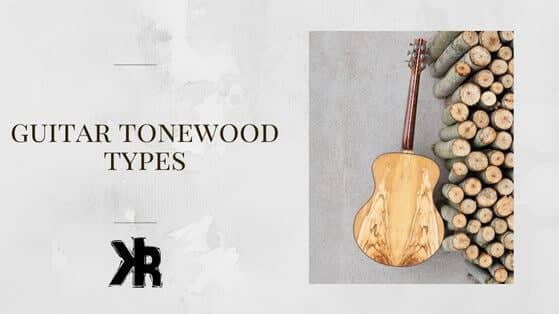Table of Contents
There are many guitar tone wood types used to make guitars, especially today! Each one with its own properties that affect the overall tone and sound of the instrument.
Mahogany is a popular choice for acoustic guitars. This is because it produces a warm, mellow sound. While alder is often used for electric guitars because it provides a bright, clear tone.
Different woods can also be combined to create custom sounds. Using an ash body with a maple neck to achieve the best of both worlds.
So if you’re looking to change up your sound, read on. This Killer Rig article will explore the different guitar tone wood types available today.
What is Tonewood?
The phrase “tonewood” is used to refer to the wood that is used to build guitars. The overall sound of the guitar can be affected by the type of wood utilized.
Different tones can be produced by various types of wood. All ranging from warm and full-bodied to bright and twangy.
There are some wood choices that are better for acoustic than electric guitars. Especially once you begin to factor in amplification. An electric guitar body does have an impact on the sound it makes, but not like an acoustic.
The Different Guitar Tone Wood Types
All wood types have their own sonic characteristics. We are going to look at 12 popular materials that are used to make the bodies of a guitar.
Alder
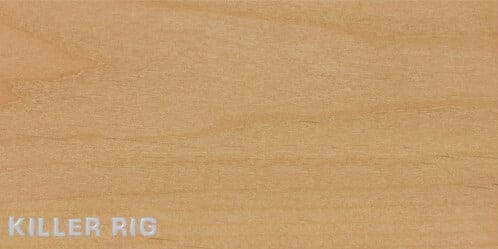
Alder is a type of wood that is often used in the construction of electric guitar bodies. It’s a lightweight wood that has a very even grain pattern. Alder is known for producing a clean and bright tone with plenty of mid-range.
Alder is used in many Fender guitar bodies. As a result, this type of wood has become well-known in the music world. Many copycat guitar brands have also begun to use it.
This wood type is soft though and can’t handle the tension of strings. So it’s not used to make guitar necks. It would buckle before you could say “Rock and Roll!”
Which is better alder or basswood? Click here!
Ash
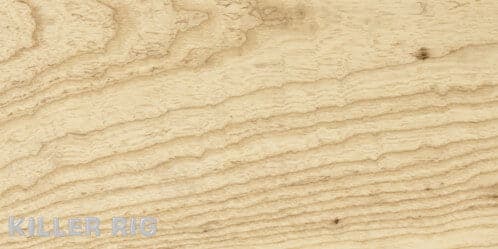
Ash is another common wood choice for electric guitars. It’s slightly heavier than alder and has a more open-grain pattern.
This wood type is referred to as swamp ash and is also used by many brands, including Fender.
Ash produces a warm and full-bodied tone with plenty of low-end frequencies. It’s often used in guitars that require a brighter, twangy tone that is still balanced. Swamp ash is also rigid enough that it can provide a good amount of note sustain.
Basswood

Basswood is a lightweight wood that is used to make electric guitar bodies. It’s known for its clean and uniform grain pattern. Basswood produces a warm and full-bodied tone with plenty of low-end frequencies.
Basswood is normally found in North America. It’s quite easy to harvest, making it very affordable.
It’s another very soft material and as such is not commonly used in the making of guitar necks or acoustics.
Is basswood good for guitars? Click here to find out!
Maple
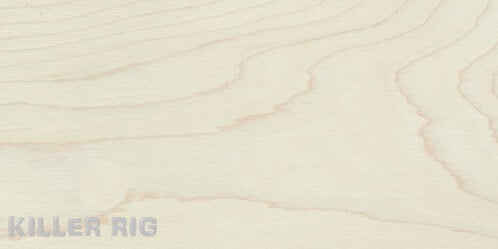
Maple is a hardwood commonly used to make electric and acoustic guitars. It’s very strong and has a tight grain pattern.
Maple is known for producing a bright and clean tone with plenty of treble frequencies.
Maple is often used as a top wood on electric guitars, especially those with a maple fretboard. It can also be used for the whole body of an acoustic guitar.
Sustain is quite good with maple because it’s so dense, which also makes it look great with the right finish.
Mahogany
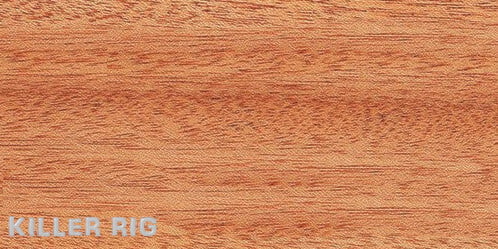
Mahogany is a very popular wood choice when it comes to making all sorts of guitars. It’s a medium-weight wood with a very dense grain pattern.
Mahogany is known for its dark tones that are broad in the low end but are very appealing.
Mahogany is often used as a preferred wood for acoustic guitars, as well as the bodies on electrics. Necks are also commonly made from mahogany, as it’s very strong and can handle the tension of strings.
Want to know the difference between alder and mahogany? Click here!
Rosewood

Rosewood is most commonly used to make fretboards, as it’s quite hard. It’s a heavy wood with an open grain pattern.
Rosewood is known for producing a warm and full-bodied tone. But with plenty of low and mid-range frequencies.
Rosewood is not used as often in constructing solid guitar bodies. But it’s sometimes used for acoustic backs and sides. It’s also a very popular material for making bridges and saddles.
Walnut
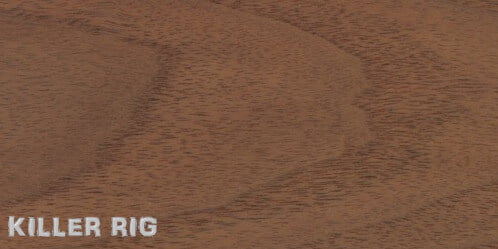
Walnut is a hardwood that is similar to mahogany in terms of weight and grain pattern. Walnut is known for producing warmer tones with tighter low frequencies. It’s a beautiful wood choice, but can get quite expensive.
Walnut is not as commonly used as some of the other woods on this list. But it can occasionally be found in electric guitars.
It’s more likely to be used in the construction of acoustic guitars.
Poplar
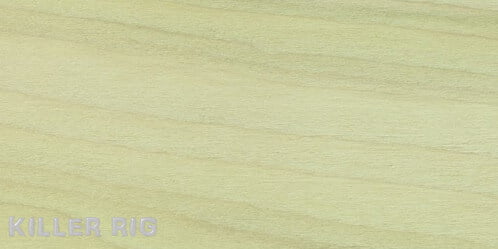
Another wood used for guitar is poplar. Poplar is also a lightweight wood that has a grain pattern similar to swamp ash in that it’s open.
It’s known for producing a pretty balanced tone, but doesn’t have a lot of sustain.
Poplar is becoming more popular as it’s beginning to be used in cheaper guitars made in Asia. While it’s not a bad wood choice, it doesn’t have great characteristics like other choices on this list.
Related: Find the best guitar colors.
Korina

Korina is a wood choice that is not as common but has some great tone characteristics. It’s known for producing naturally warm tones that have good balance. Korina is also quite rigid, so it has good sustain.
This wood was once popularized by Gibson in the 1950s when they used it to make the Flying V and Explorer. These days it’s not as commonly used, but can still be found in some higher-end guitars.
Koa
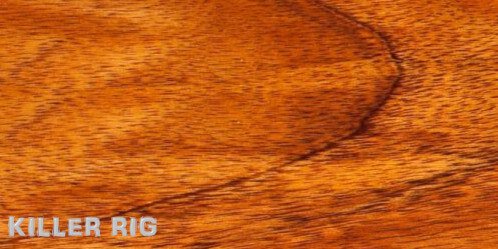
Koa is a wood that is native to Hawaii and is becoming more popular in the guitar world. It’s not a very heavy wood, but does have busy grain patterns. Koa is known for its bright and punchy tone with some good mid-range focus.
Koa is often used as a top wood on acoustic guitars, as it can really add some nice detail to the sound.
It’s also becoming more popular for electric guitars. Especially those with a semi-hollow or hollow body design.
Sitka Spruce
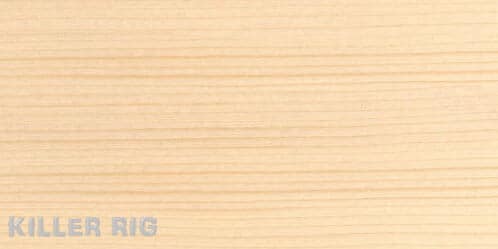
Most commonly used on acoustic guitars as a soundboard, Sitka Spruce is a very common tone wood. It’s a very light and stiff wood that has a tight grain pattern. Sitka spruce is known for its bright and clear tone with plenty of highs.
This wood is also sometimes used in electric guitars. Mainly those with a hollow body design. It can really add some nice articulation to the sound with good volume projection.
Cedar
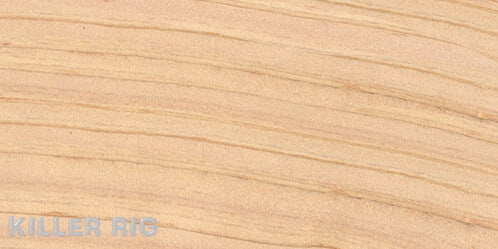
Cedar is a wood most commonly used as a soundboard on acoustic guitars. It’s a very light wood that is popular on classical instruments.
Cedar is known for its warm and full-bodied tone with plenty of volume.
This wood is rarely used on electric guitars. For the most part, it will be found on classical and steel-string acoustic guitars.
How to Choose the Right Tone Wood for Your Guitar
Choosing the right tonewood for your guitar involves exploring different options and listening closely to their sounds. Each type of wood produces a specific tone, and the one that appeals to you most is your best choice.
Guitars vary greatly in terms of wood, and there’s no universal best option. It’s about finding the wood that resonates with you personally. Look for a connection with the wood rather than perfection. Choose the one that brings you joy.
When selecting a tonewood, consider its weight. Heavier woods usually offer more sustain, while lighter ones tend to be brighter with less sustain. If you play gigs, ensure the guitar is comfortable to carry for long periods.
Also, think about the grain pattern of the wood. Tight grain patterns often result in a warmer sound, whereas open grains are brighter and more resonant.
Consider what sound you prefer. If you want a warm, soft tone, woods like mahogany or walnut may be ideal. For a brighter sound with more clarity, swamp ash or alder could be better choices.
Learn more about guitar neck wood types here!
Examples of Guitars with Different Tone Woods
Manufacturers go to great lengths to choose the right woods for their guitars. Guitars are typically designed and constructed with particular tones in mind.
Here are a few examples of guitars designed for various musical genres, depending on what you’re looking for.
Check out our article on the weights of the most common guitars!
Fender Stratocaster

The Fender Stratocaster is a widely admired guitar, recognized and used by famous musicians like Jimi Hendrix and Eric Clapton.
Its popularity is largely due to its design and construction. The body of the Stratocaster is typically made from alder and the neck from maple, which contributes to its bright, classic sound.
Gibson Les Paul
The Gibson Les Paul is a well known guitar, favored by famous musicians like Slash and Jimmy Page. Its sound has played a significant role in music history.
The appeal of the Gibson Les Paul lies in its construction. It’s usually made from mahogany, a dense wood that contributes to its warm, rich sound. Additionally, the top part of the guitar is often crafted from maple, which enhances the guitar’s sustain.
When you hear music played on a Gibson Les Paul, you’re experiencing the combination of these two woods.
The warm tones of mahogany paired with the sustaining quality of maple create a specific and recognizable sound, making the Gibson Les Paul a celebrated and iconic instrument in the music world.
PRS Custom 24
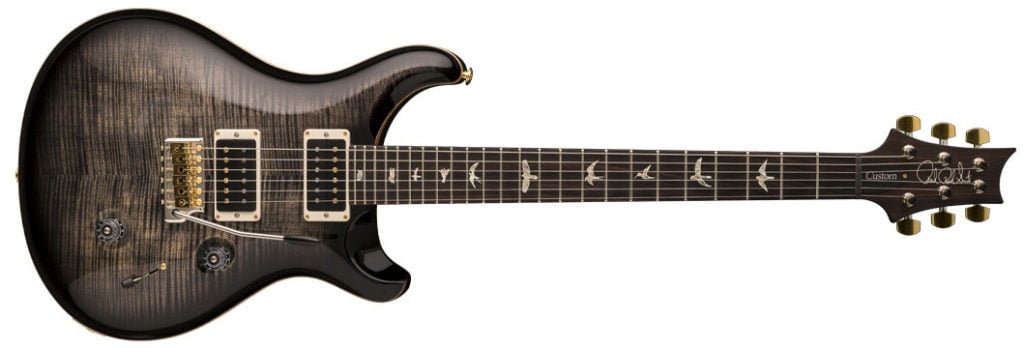
This PRS Custom 24 is treasured by pros around the world. This isn’t just your run-of-the-mill instrument. It’s a marvel, truly.
The secret to its allure is Its body, carved from rich mahogany, paired with a glossy maple top. When you strum those strings, what you hear is something special. A sound that is full and warm, resonating deep within you.
Acoustic Guitars
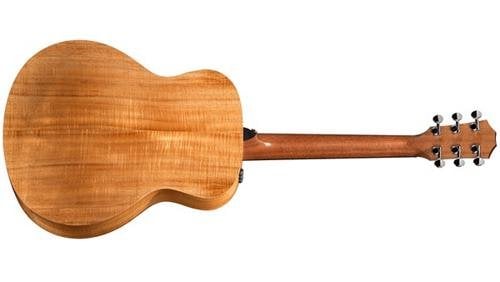
Acoustic guitars are usually made with woods like spruce, cedar, or mahogany. These woods all have different tonal qualities. This makes them well-suited for different styles of music.
Spruce is a bright and lively wood that is often used for fingerstyle or country music. Cedar is a bit warmer sounding and is often used for jazz or blues. And mahogany is a warm and full-sounding wood that is often used for anything from country to rock.
Conclusion
Well, you’ve got a world of woods at your fingertips, each with its own special ring. It’s like a playground of sounds, and finding the one that sings to your rhythm is a bit of a treasure hunt.
There’s no secret map or magic trick here, you’ve got to roll up your sleeves and give ’em a try. Only then will you hit the bullseye, finding the timber that truly matches your groove.

